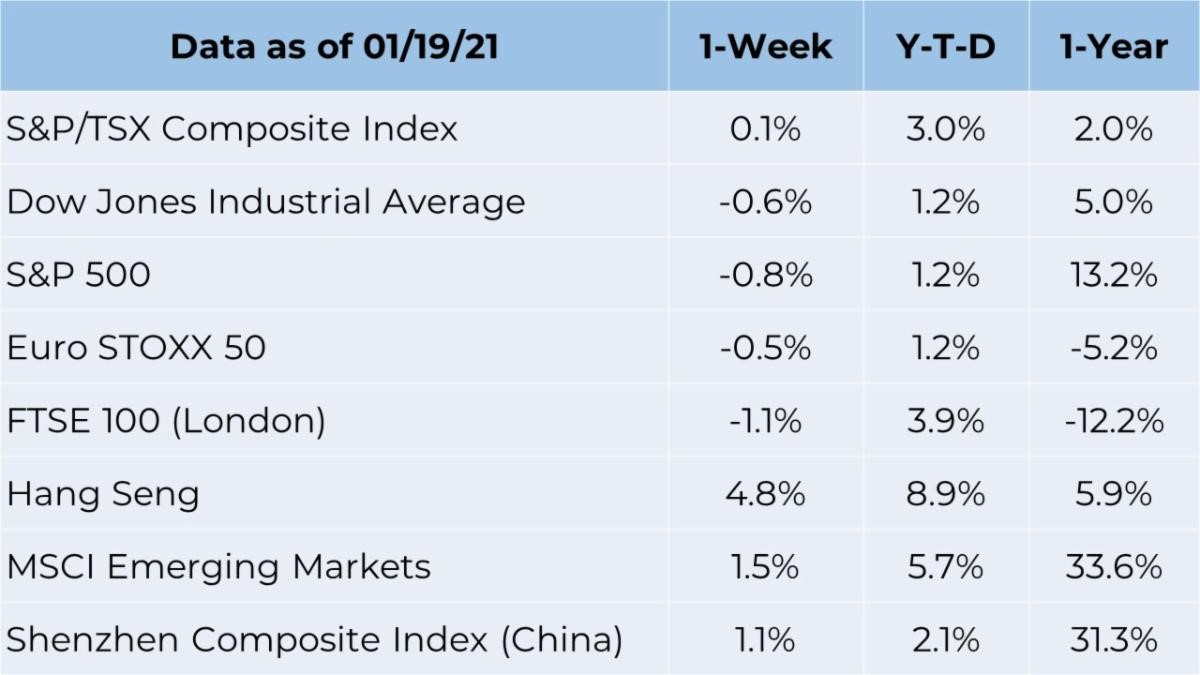Weekly Market Commentary January 21st 2021
The Markets
Economic data showed that the economy slowed in December.
Ben Levisohn of Barron’s reported:
“This past week – with the market looking ahead to the inauguration and what might be in store following the Capitol riots and Donald Trump’s second impeachment – was a terrible one for economic data. Whether it was small-business confidence, consumer inflation, or just about anything else, the numbers painted a picture of an economy that was slowing more rapidly than expected. Initial jobless claims, which spiked to their highest level since August, and retail sales, which fell 0.7 percent, were particularly frightening.”
On Thursday, U.S. President-elect Biden explained his $1.9 trillion economic relief package. The announcement of new stimulus didn’t move investors. That may be because the potential impact of a new stimulus plan has already been priced into markets, as has the new administration’s longer-term plans for infrastructure spending, reported Katherine Greifeld of Bloomberg. The relief package that passes Congress may be smaller – about $1.1 trillion, according to a Goldman Sachs economist cited by Randall Forsyth of Barron’s.
Investors are keeping an eye on inflation, which remains relatively low but has begun trending higher, according to Jeffry Bartash of MarketWatch. During the past few months, the core rate of inflation has remained below 2 percent in Canada and the U.S., however, inflation expectations and bond yields have been moving higher, reported Jonnelle Marte, Ann Saphir, and Howard Schneider of Reuters. As bonds provide more attractive returns, income investors may shift away from stocks and into less risky opportunities.
Last week, the S&P 500 index lost more than 1 percent for the first time since October.

Source: Refinitiv

January 21st at 7:00 PM - Click Here To Register
Trading teeth for treasure during the pandemic
Around the globe, the pandemic helped make 2020 one the most challenging years ever for dentists. The Dental Tribune reported most dental offices around the world closed their doors in March. While most eventually reopened, the impact on dental practices and suppliers was significant. Many adopted cost-cutting measures.
The Tooth Fairy did not suffer the same fate.
In August 2020, Delta Dental’s Original Tooth Fairy Poll® found, “…the Tooth Fairy’s average cash gift increased 30 cents for a lost tooth [in the United States], for a total of $4.03 per tooth.” The value of a lost tooth has tripled since the poll began in 1998. (The Tooth Fairy exchange rate was about $1.30/tooth back then.)
Four dollars may seem steep, but the United States isn’t the only country where lost teeth command a high price. For example:
- Canadian kids receive $5.36 Canadian or $4.38 American.
- Japanese children receive ¥437.93 from the Tooth Fairy. That’s about $4.22.
- Ireland and Spain, a baby tooth is worth €3.64 or $4.41.
- Brazilian parents get off lighter. A tooth there is valued at R$17.12 or $3.27.
Visits from the Tooth Fairy offer teachable moments – times when kids may be interested in learning about money. One way to get the discussion going is to ask recipients of the Tooth Fairy’s generosity how they plan to spend the money. Once you’ve listened to the answer, you may want to offer other ideas like saving or donating part of the money. If you would like more ideas, let us know.
Weekly Focus – Think About It
“Inflation is when you pay fifteen dollars for the ten-dollar haircut you used to get for five dollars when you had hair.”
--Sam Ewing, Baseball player
Best regards,
Eric Muir
B.Comm. (Hons.), CIM®, FCSI
Portfolio Manager
Tracey McDonald
FCSI, DMS, CIM®
Portfolio Manager

